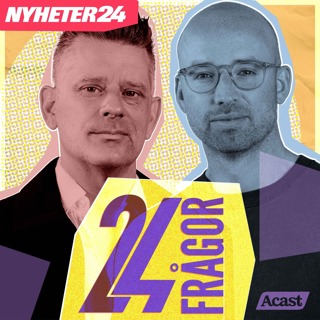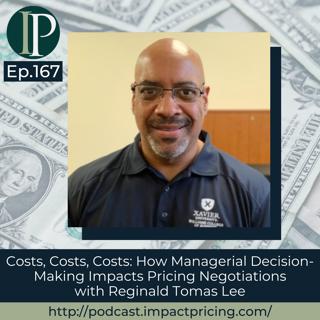
Costs, Costs, Costs: How Managerial Decision-Making Impacts Pricing Negotiations with Reginald Tomas Lee
Reginald Tomas Lee is a Professor of Business Analytics at Xavier University in Cincinnati, Ohio. He has a PhD in Mechanical Engineering, and he's been involved in supply chain since ’96. Reginald’s most recent book is called Project Profitability. And one fun thing, he can't go on vacation, because he has two killer dogs. In this episode, Reginald shares wisdom with regards to the modeling he’s been making as he talks about the power of helping people understand more clearly how what it is that they do impacts cash. Why you have to check out today’s podcast: Understand why you should start seeing things from a cash perspective in relation to knowing what it is that it enables you to save Learn about the difference of cash cost and non-cash cost through situational examples from real life experiences Find out how your actions and decisions impact how you generate cash in a business “Don’t focus on accounting margins.” – Reginald Tomas Lee Topics Covered: 01:17 – How Reginald shifted from being a mechanical engineer to thinking about supply chains and costing 03:44 – What Reginald does: Helping people understand how their decisions impact cash 07:18 – Talking about contribution margins: Accounting for things from a cash perspective 11:09 – How to figure out the optimal price without using some measure of contribution margin 14:34 – Hope as a strategy: Mark’s opportunity cost vs. Reginald’s opportunity revenue 17:15 – Two types of costs: The cash cost and the non-cash cost 21:41 – Reginald’s sales pitch: Very specifically identifying what the savings are 24:02 – Discussion about Mark’s value table and Reginald’s improvement projects 27:59 – Projecting revenue and the uncertainty that comes with it 30:24 – Reginald’s piece of pricing advice for today’s listeners Key Takeaways: “We should shift away from looking at accounting data and look specifically at operations and cash.” – Reginald Tomas Lee “From a cash perspective, materials and labor don't vary. When we look at contribution margins for products that we make, and we assume that those costs vary and they affect the contribution margin, my argument is they don't vary. And so therefore, it's not a reflection of cash.” – Reginald Tomas Lee “As we know, hope’s not a strategy. We’re hoping that the demand would be there, but I've seen situations, actually, where people have bought more just to get a lower price so that they can report a higher gross margin. It's not a good business decision at all. And that's why I shift over to cash, because cash will tell you don't do that, but accounting may, because I can put it in inventory.” – Reginald Tomas Lee “If you want to save money, what you have to do is basically buy fewer people. Buy four people instead of buying 10 people. Buy less capacity, then I'm spending less money.” – Reginald Tomas Lee “I focus specifically on what changes the software will enable, and then point out that if you want the cash savings, you need to make managerial decisions. You have to make a decision to get rid of the four people because the software is not going to fire them. That's what you have to do. The software is not making the cost savings happen. It's my management decision and action that was at that.” – Reginald Tomas Lee “I define efficiency as engineers do – output over input. So, if my input is my organization, what I'm spending on the organization, and the output is what it is that they can do, then what this will do is that we’ll generally allow them to either create more output with the same group, or consume less of that group to create the existing amount of output. But the size of the organization itself doesn't change until I, as a manager, change it.” – Reginald Tomas Lee “Based on how we choose to calculate this cost, that may have an impact on whether we take the business or not. So instead of focusing on accounting margins, if you can take a look at the cash impact of the decision that you make, then I think you'll be in a much better position to be able to negotiate price and feel good about taking prices that in some cases you may not have taken just because someone calculated a number that happen to be lower than someone else's calculation.” – Reginald Tomas Lee People / Resources Mentioned: Project Profitability: https://www.amazon.com/Project-Profitability-Ensuring-Improvement-Projects/dp/1637421699 The Goal: https://www.amazon.com/Goal-Process-Ongoing-Improvement/dp/0884271951 Connect with Reginald Tomas Lee: Email: reginald.lee@bdrco.org LinkedIn: https://www.linkedin.com/in/reginaldtomas/ Connect with Mark Stiving: LinkedIn: https://www.linkedin.com/in/stiving/ Email: mark@impactpricing.com
4 Apr 202232min

Blogcast #48: Direct Customer Impact
This is an Impact Pricing Blog published on February 23, 2022, turned into an audio podcast so you can listen on the go. Read Full Article Here: https://impactpricing.com/blog/direct-customer-impact/ If you have any feedback, definitely send it. You can reach us at mark@impactpricing.com. Now, go make an impact. Connect with Mark Stiving: Email: mark@impactpricing.com LinkedIn: https://www.linkedin.com/in/stiving/
1 Apr 20223min
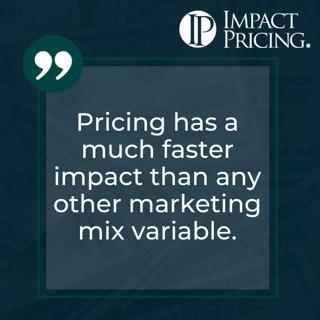
Memecast #51: Price is Fast
It's true, pricing can have an instantaneous response. I often think of it as the nuclear bomb of marketing mix variables because you can change it today, impact the market immediately, and it's really hard to take it back. Now, compare that to the other marketing mix variables. If you've taken a marketing class, you know the four P's. You know the other three besides price, or your product, your place, and your promotion. Product is obviously, what are we building? The place is, what's the distribution channel look like? And then the promotion is, how are we marketing it? How are we talking about it in the marketplace? We could change our marketing. We could change our product. We could change our distribution channel. And each one of those would have an impact on our revenue, on our sales. But it takes a long time for that impact to ripple through. On the other hand, if I change price today, people will change their mind today. Some people will choose to buy, some people will choose not to buy, simply because of the price change. So price really does have the fastest impact, but it also is one of the most dangerous to use. If you're using price to gain share, you're probably just driving industry profits down. So, although it's fast, be very careful how you use it. We hope you enjoyed this memecast. If you have any questions or feedback, please email me mark@impactpricing.com. Now, go make an impact. Connect with Mark Stiving: Email: mark@impactpricing.com LinkedIn: https://www.linkedin.com/in/stiving/
30 Mars 20222min
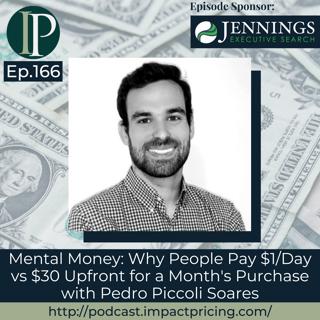
Mental Money: Why People Pay $1/Day vs $30 Upfront for a Month's Purchase with Pedro Piccoli Soares
Pedro Piccoli Soares is currently Senior Executive Manager of AI Pricing at SIXT, a travel arrangement / car rental company that’s known to be a provider of high-quality mobility services. He mentors startups, and has an Engineering degree. He also has a purple belt in Brazilian jiu-jitsu. In this episode, Pedro shares his knowledge when it comes to behavioral economics as he and Mark talk about how it works in relation to mental accounting and pricing. Why you have to check out today’s podcast: Discover why it’s important for companies to understand why they’re doing pricing and why they’re having a price change Understand why you should still be relative to your competitors’ price change even when they’ve already made the mistake of decreasing their prices Learn more about behavioral economics, its tactics, and its relationship with mental accounting and pricing “So, we've mentioned several different effects of behavioral economics and several different examples of how they can be applied on real business. If you think about it, they were quite simple, right? It's really easy to test these kinds of things, and they can generate some really nice benefits to your company, for sure.” – Pedro Piccoli Soares Topics Covered: 01:40 – The internship that led to Pedro’s shift from being an Engineer to doing pricing 03:09 – What Pedro loves about pricing that made him stay in it 05:34 – Why it’s important for companies to understand why they’re doing pricing and why they’re having a price change 07:38 – Being relative to competitors’ price change even when they made the wrong decision 10:20 – Talking about behavioral economics; what Mark doesn’t like about it 12:33 – Behavioral economics’ tricks: Pedro and Mark’s perspectives in relation to price endings in relation to mental accounting 18:49 – Discussion about what loss aversion is 20:38 – The use and importance of loss aversion, especially in business 23:23 – Behavioral economics and people’s buying decisions in relation to good, better, best 25:53 – Pedro’s piece of pricing advice for today’s listeners Key Takeaways: “This is when you kind of lose the sense of why you're doing the price change. If you just follow your competition, if you don't know the reason why you're changing the prices, you can initiate a fight that in the end has no background or no reason to be happening. You are assuming that everything that they are doing is right, and that they know why they are changing prices. It might be the case, but might be the case that they are also doing something wrong and you're just following them. You need to understand your customers and what price changes will affect them. You need to have a reasoning you apply when you’re changing the price.” – Pedro Piccoli Soares “I totally agree that behavioral economics cannot generate as much value as pricing departments can generate. And it’s, on the other hand, a much nicer topic to talk about to show results. You can definitely play around and create experiments, and you can very easily show the results of a try, and it's something that calls people attention because it's actually behavior, and that's something that they do as well, right? So, everybody wants to listen and to hear about heuristics, or the mistakes, the biases that they take when they're making decisions. And that's why I think it's a topic that costs more attention than pricing.” – Pedro Piccoli Soares “When you have two different people, we have so many different characteristics that it's harder to compare. And if you have just two similar options, one, which is clearly worse than the other, you make the choice easier.” – Pedro Piccoli Soares People / Resources Mentioned: SIXT: https://www.sixt.com/ Dan Ariely: https://danariely.com/ Connect with Pedro Piccoli Soares: LinkedIn: https://www.linkedin.com/in/pedro-piccoli-soares/ Email: piccolisoares@gmail.com Connect with Mark Stiving: LinkedIn: https://www.linkedin.com/in/stiving/ Email: mark@impactpricing.com
28 Mars 202228min
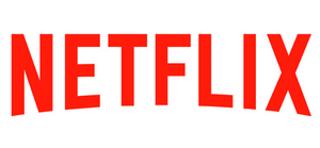
Blogcast #47: Another Netflix Increase
This is an Impact Pricing Blog published on February 16, 2022, turned into an audio podcast so you can listen on the go. Read Full Article Here: https://impactpricing.com/blog/another-netflix-price-increase/ If you have any feedback, definitely send it. You can reach us at mark@impactpricing.com. Now, go make an impact. Connect with Mark Stiving: Email: mark@impactpricing.com LinkedIn: https://www.linkedin.com/in/stiving/
25 Mars 20223min
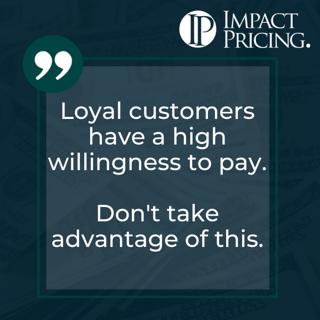
Memecast #50: Loyal Customers
The whole point of pricing, value-based pricing, is to charge what customers are willing to pay. And almost by definition, loyal customers like us more, they would be willing to pay us more. This is the big exception to the rule of charge what a customer is willing to pay. My intent when I do price segmentation and charge different customers different prices is I also want to think about the lifetime value of a customer. If you have a customer who loves you, they're very loyal to you, and yet they find out that you are charging them more than anybody else, it will upset them. You have a really high probability of losing them as a customer. And if you do, you lost the lifetime stream of value. So, my advice, treat loyal customers really, really well, and don't charge them more than other people. We hope you enjoyed this memecast. If you have any questions or feedback, please email me mark@impactpricing.com. Now, go make an impact. Connect with Mark Stiving: Email: mark@impactpricing.com LinkedIn: https://www.linkedin.com/in/stiving/
23 Mars 20221min
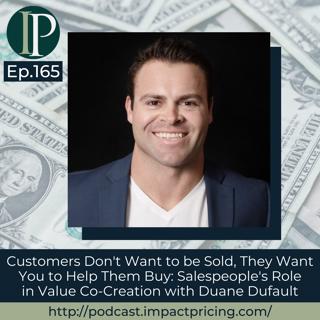
Customers Don't Want to be Sold, They Want You to Help Them Buy: Salespeople's Role in Value Co-Creation with Duane Dufault
Duane Dufault is currently a Fractional CRO at Forward and is a Strategic Advisor at Abaqus Inc. Before this, he was Fractional VP of Sales at The RockED Company Inc. Duane is a dad of four lovely daughters. In this episode, Duane shares the power behind having all departments in a company understand value in order to help the customer see and understand value as well in accordance with their reasons for buying a product. Why you have to check out today’s podcast: Discover why it’s important for you to teach your sales reps to unpack value and not create it Find out why it’s a must for you to help people understand what it is that they’re actually paying for upon purchasing your product Understand the reason behind having clients voice out their problem and a salesperson being able to connect the product as a solution to what a client needs to be solved “Just make it easy, seriously. The easier you can make it for people to figure out the pricing on your product, the easier it is for them to buy. Simple.” – Duane Dufault Topics Covered: 01:15 – The connection between Duane’s role and pricing 02:14 – That time when Duane realized the immense need for product management to focus on pricing 05:26 – Talking about the similarities and differences of product marketing and sales roles 09:50 – Should salespeople have the authority when it comes to pricing? 14:36 – Why salespeople need to unpack value, not create it 17:12 – Reminiscing Mark’s first few years as a salesperson 18:42 – Making a difference in the market in relation to value and what the customer’s needs are 23:08 – The difference between a CRO and a VP of Sales in Duane’s perspective 25:27 – Duane’s piece of pricing advice for today’s listeners Key Takeaways: “One of the growth levers that I was looking at is like how was pricing structured for whatever product it is because that's a really big indicator on how people are going to buy from your company. If you've got hard to understand pricing, that's a problem. And that's friction in the buying process that you need to remove.” – Duane Dufault “Product marketing and a good sales process are like two sides of the same point. It's like sales and marketing, but like, a good sales process and product marketing is so closely tied, because the questions that a good product marketer asks are a lot of the same ones you get from a sales conversation, a discovery process, and they take them down the same path. “Product marketing is fascinating from my perspective because you need to have a certain perspective on customer engagement and usage to understand how to shape and evolve both the product, the customer journey, and what they pay for the product.” – Duane Dufault “If you've got a sales rep that's very, very focused and narrow-minded on one specific area, they can't pull from other experiences.” – Duane Dufault “Teach your reps how to unpack value, not add value.” – Duane Dufault “If you come into your discovery process with a deck that just has a whole bunch of bullets of stuff that came from the marketing page, that's not a value to them. They only find it valuable when they find it valuable, and it's only valuable when it solves a problem. And you can't solve a problem until you ask him what those problems are.” – Duane Dufault “If you have a good discovery process that's focused on the needs of the buyer, you're going to help them figure out what those differences are, because people buy on an emotional trigger, and then cancellation happens when they find those little things that don't meet up with what they really want to do. In the sales process and marketing, marketing is there to take feedback from products, to then communicate what everyone gets from it, so that way, when the prospect gets the salesperson, it's the salespersons job to unpack those little things, because those little things are going to be the reason why they don't cancel in a year.” – Duane Dufault People / Resources Mentioned: Metric Manager Playbook:https://themetricmanager.com Connect with Duane Dufault: LinkedIn:https://www.linkedin.com/in/duanedufault/ Email: duane@sellingsaas.io Connect with Mark Stiving: LinkedIn: https://www.linkedin.com/in/stiving/ Email: mark@impactpricing.com Website:https://www.duanedufault.com/
21 Mars 202227min

Blogcast #46: You Must Lose on Price
This is an Impact Pricing Blog published on February 9, 2022, turned into an audio podcast so you can listen on the go. Read Full Article Here: https://impactpricing.com/blog/you-must-lose-on-price/ If you have any feedback, definitely send it. You can reach us at mark@impactpricing.com. Now, go make an impact Connect with Mark Stiving: Email: mark@impactpricing.com LinkedIn: https://www.linkedin.com/in/stiving/
18 Mars 20222min







